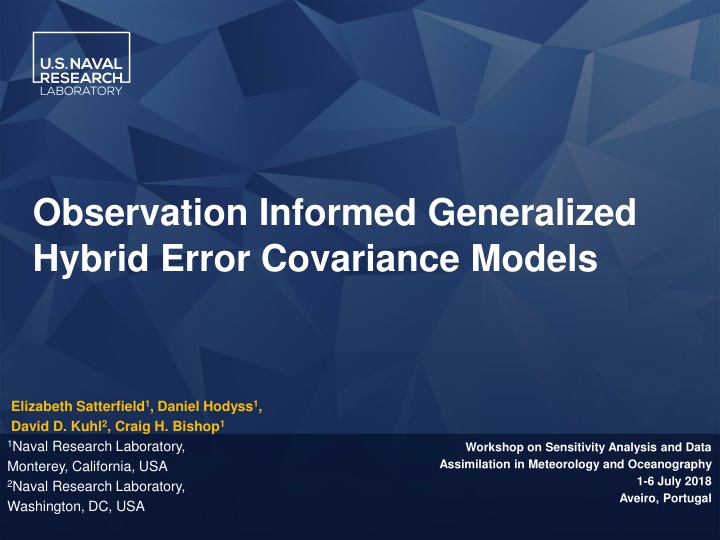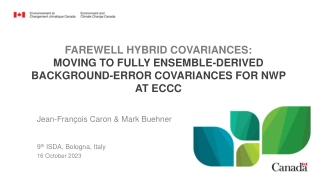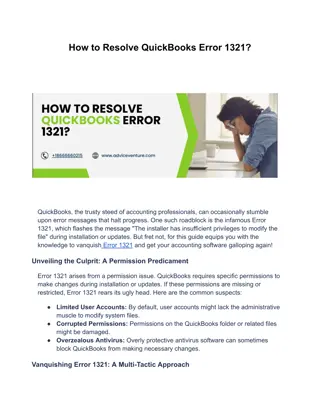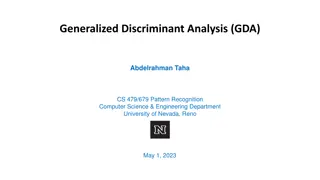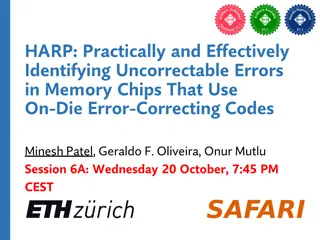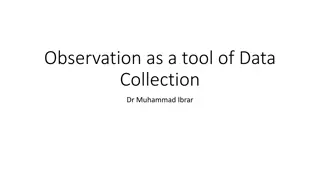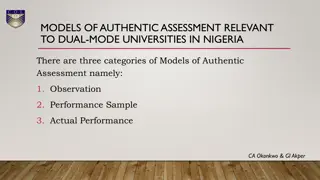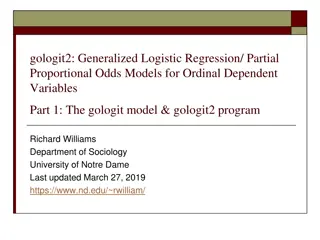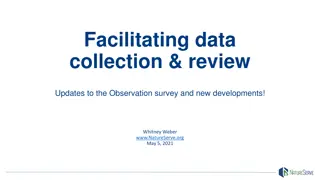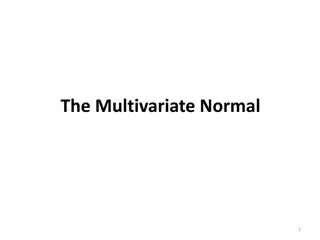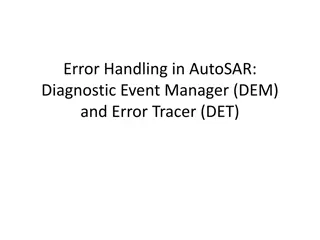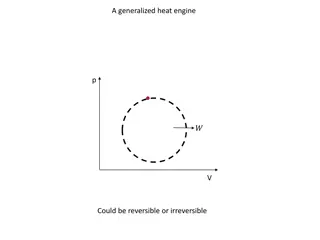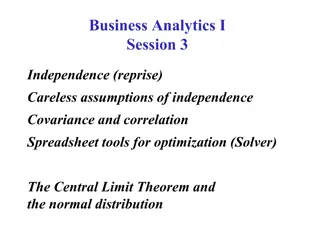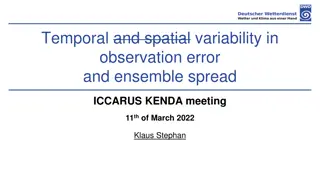Investigation of Observation-Informed Generalized Hybrid Error Covariance Models
In the field of meteorology and oceanography, the study focuses on the development of hybrid error covariance models that combine flow-dependent and climatologically-based estimates for improved data assimilation. The research aims to determine optimal hybridization parameters through innovative methods using observational information and regression techniques. By analyzing variance distributions and establishing regression models, the study seeks to enhance forecast accuracy in chaotic systems like the atmosphere.
Download Presentation

Please find below an Image/Link to download the presentation.
The content on the website is provided AS IS for your information and personal use only. It may not be sold, licensed, or shared on other websites without obtaining consent from the author.If you encounter any issues during the download, it is possible that the publisher has removed the file from their server.
You are allowed to download the files provided on this website for personal or commercial use, subject to the condition that they are used lawfully. All files are the property of their respective owners.
The content on the website is provided AS IS for your information and personal use only. It may not be sold, licensed, or shared on other websites without obtaining consent from the author.
E N D
Presentation Transcript
Observation Informed Generalized Hybrid Error Covariance Models Elizabeth Satterfield1, Daniel Hodyss1, David D. Kuhl2, Craig H. Bishop1 1Naval Research Laboratory, Monterey, California, USA 2Naval Research Laboratory, Washington, DC, USA Workshop on Sensitivity Analysis and Data Assimilation in Meteorology and Oceanography 1-6 July 2018 Aveiro, Portugal
Introduction In a chaotic system like the atmosphere, the true error covariance of short term forecasts is highly flow dependent. Ensembles can capture such flow dependence, however limited ensemble size and imperfections in methods used for initial condition and model error perturbations mean that ensemble covariances are inevitably inaccurate. Hybrid error covariance models, which combine flow dependent (localized, ensemble-based) and quasi-static (climatologically- based) error covariance estimates, have been shown to yield superior data assimilation performance. 2
Introduction A primary aim of this work is to investigate the extent to whichoptimal hybridization parameters can be derived from an archive of (observation-minus-forecast, ensemble-variance) pairs generated by a single long run of a hybrid data assimilation scheme. Such an approach is attractive due to its simplicity and flexibility, benefits from the use of observational information, and has the potential to greatly reduce the amount of time required to tune hybrid error covariance models 3
Regression Based Model for the True Prior Variance Binned Sample-True Variance Linear Regression Fit Bishop and Satterfield (2013) detail a distribution of true variances, given an imperfect ensemble estimate. Here, we generalize this idea by estimating the mean of this conditional density using the techniques of regression. Although, in practice, the true error variance is unknown, this quantity can be estimated as the difference between the innovation variance and the observation error variance, where observation error variance estimates are obtained using methods of Desroziers et al. (2005) among others. Flow Dependent Static
Regression Based Model for the True Prior Variance Binned Sample-True Variance Linear Regression Fit A traditional linear model would take the form: t2~ -1( t=3 t=2), A nonlinear relationship between the ensemble variance and true error variance implies a more general form, t2~a+bu, u~U(0,1)
Defining the Kalman Gain Average error variance in a Kalman state estimate is We perform the standard operations to derive the Kalman gain, G, that minimizes the posterior error. We take the derivative of Pa with respect to G and set the result equal to zero. Solving for G: The gain that minimizes the posterior variance uses the expected true prior variance given an ensemble variance
Lorenz 96 Model Experiments One-to-One Ne=5 linear Binned Sample-True Variance We assess the regression based models of hybrid error covariance using an implementation of the perturbed observations form of the Ensemble Kalman Filter (EnKF) on a 10-variable version of the Lorenz 96 model. Gaspari-Cohn localization is applied to the ensemble based covariance matrix Every grid point is observed at each time step Multiplicative variance inflation is used to ensure that the ensemble variance approximately equals the mean squared error. A static error covariance matrix is generated from a 100,000 time step run of fully ensemble based system Cubic regression gives a better fit than linear for 5 member case True Error Variance Ne=5 cubic For larger ensemble sizes, errors in the linear approximation are not as large Ne=10 linear Inflated Ensemble Variance
Lorenz 96 Results: Tuning versus Regression Based Models Ne=5 Linear regression underestimates the optimal we=0.7 found by brute force tuning The cubic regression based hybrid shown in red gives a lower RMSE than any of the linear models. we
Lorenz 96 Results: Influence of Model Error and Observation Density Brute force now finds minimum posterior error with we=0.6 consistent with a less accurate ensemble Little difference is seen between the cubic and linear fits Include model error by changing the forcing in the nature run from F=8 to F=10 Brute force minimum posterior error (calculated over all points) with we=0.7 Observe only 50% of the grid points The cubic and linear fits converge
NAVGEM Results: Tuning versus Regression Based Models Alpha=1.00 Alpha=0.75 Alpha=0.50 Alpha=0.25 Brute force tuning Red indicates improvement 600 hPa 400 hPa from Deszroiser Method Linear Regression Analysis with Prior Variance Cubic 400 hPa 600 hPa U.S. Naval Research Laboratory
Main Conclusions In this study we built on the findings of Bishop and Satterfield (2013) to show that the expected true prior variance given an ensemble sample variance is consistent with regression. Theory was developed to show that (when only the sampling error in the ensemble variance was considered) the gain that minimizes the posterior error variance uses the expected true prior variance given an ensemble sample variance. We demonstrated that, after a single run of a fully ensemble data assimilation scheme, one can use regression to obtain a model of optimal hybrid variance. 11
Main Conclusions For the idealized univariate data assimilation and multi-variate cycling ensemble data assimilation considered here, it was found that, when the relationship between the ensemble variance and true error variance is linear, linear regression closely approximates the optimal weights found through the simple, but computationally expensive process of testing every plausible combination of weights. For the case that the relationship between the ensemble variance and true error variance is nonlinear, we introduce a hybrid model defined by higher order polynomial regression and demonstrated that such a scheme outperformed any plausible linear model. The degree to which higher order polynomial regression outperforms the best linear model is dependent on the performance of the ensemble. Typically, fitting to a higher degree polynomial is most important when the ensemble variance more accurately tracks the true error variance. 12
Future Work The focus of this work has been on hybrid formulations which form a hybridized error covariance matrix (e.g. Hamill and Snyder, 2000) and for filters which assimilate all available observations at once. Additional work would be needed to implement in serial filters. The theory presented here has only been applied to variances and additional work is needed to account for correlations, although similar methodology could be applied. These issues as well as application of this theory to the Navy Global Environmental Model (NAVGEM) are the subject of future work. 13
References Bishop, C. H., E. A. Satterfield, 2013: Hidden Error Variance Theory. Part I: Exposition and Analytic Model. Mon. Wea. Rev., 141, 1454 1468. Bishop, C. H., E. A. Satterfield, K. T. Shanley, 2013: Hidden Error Variance Theory. Part II: An Instrument That Reveals Hidden Error Variance Distributions from Ensemble Forecasts and Observations. Mon. Wea. Rev., 141, 1469 1483. Desroziers, G., L. Berre, B. Chapnik, and P. Poli. Diagnosis of observation, background and analysis-error statistics in observation space. Quart. J. Roy. Meteor. Soc.,131:3385 3396, 2005. Gaspari, G. and S. E. Cohn, 1999: Construction of correlation functions in two and three dimensions. Q. J. R. Meteorol. Soc., 125, 723 757. Hamill, Thomas M., Chris Snyder, 2000: A Hybrid Ensemble Kalman Filter 3D Variational Analysis Scheme. Mon. Wea. Rev., 128, 2905 2919. Lorenz, E.N., 2005: Designing Chaotic Models. J. Atmos. Sci., 62, 1574 1587. Satterfield, E., D. Hodyss, D.D. Kuhl, and C.H. Bishop. On the Likely Utility of Hybrid Weights Optimized for Variances in Hybrid Error Covariance Models . Mon. Wea. Rev. In Review. 14
